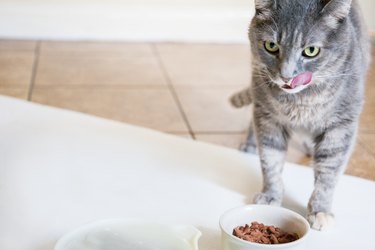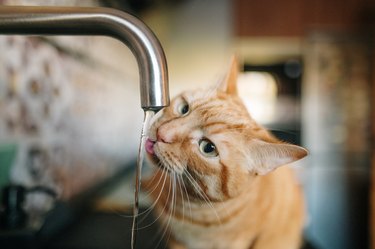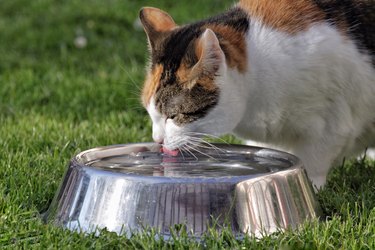How much water should a cat drink? You share your life and love with your cat, who returns that affection — sometimes in her own way. There's something else you share with your cat — your cat is also largely comprised of water; 60 percent to 70 percent of an adult cat's body weight. But while we can easily monitor our intake, it can be challenging to know if your cat is getting enough water.

Video of the Day
Cues about hydration
Here are a few ways to help determine if your cat should be drinking more water:
Video of the Day
A dehydrated cat will often be lethargic and have sunken eyes, dry mouth, panting, and loss of appetite. Cats seriously deficient in water consumption can become extremely ill.
If your cat isn't drinking enough, she likely won't be going to the bathroom enough. Check the litter box for liquid-made clumps. Most adult cats urinate two or three times a day.
Just as water helps us with our skin and hair, they signal good hydration in cats, too. A dehydrated cat may have a dull coat and flakey skin. Another skin test is for elasticity. If you pull the scruff of a cat's neck, a properly hydrated feline's scruff should "bounce" back to its original position quickly.
Tips for drinking more
Because water is crucial to a cat's well-being, including preventing severe illnesses such as feline urological syndrome, it may take some extra effort to get your pet to drink enough. Consider the possible changes that can be made with the bowl, the food and the water.
Different bowl types
You know that mug in your cupboard that you never use? Cats, too, can be particular about this. Some cats may dislike plastic, so trying ceramic or stainless steel may make a difference. Place multiple bowls around the house for more access and to determine if your cat has a favorite bowl based on substance or location.
Along with material, the depth of the bowl may make a difference. If the tall, deep bowl stays full, try a wider, shallow one. Consider a fountain bowl. Some cats enjoy the mental stimulation that comes from this interactive device. Before tossing all the bowls, make sure you see your cat drink from the fountain.

It may seem counterintuitive but try keeping water bowls away from your cat's food. The smell of the food near the water can deter some cats from drinking. Also, some cats don't like food particles in their water bowl. Picky? Maybe, but you probably have that preference in common with your cat, too.
The food matters
Because dry food typically contains 7 percent to 12 percent water, while wet food boasts up to 80 percent, one of the easiest ways to boost water intake is to feed your cat wet food. Simply adding water to dry food is not a recommended alternative. That can make the food soggy, or even spoiled.
Wet food also has the additional benefits of high protein and lots of flavors, so your cat gets a variety of great tastes with the consistent delivery of healthy nutrition.
Change the water daily
Changing the water in a cat's bowl daily makes it more attractive and wash the bowl frequently. You might find that she prefers bottled or filtered water. This may sound a little pretentious, even for cats, but if your tap water has chlorine or excessive minerals, cats may find the smell or taste unpleasant. Consider adding ice cubes or chips. Your cat may enjoy the different temperature and texture that comes from adding those frozen water bits to the bowl.
Finally, even though the bowl contains plain water, that doesn't mean it doesn't get dirty. Bacteria can form, so the bowl should always be thoroughly cleaned and rinsed each day.
There's a sweet spot where you know your cat is getting enough water. Any sudden increase, or decrease, in water consumption warrants a trip to the vet. Aside from that, while it make take some extra effort — and bowls — to keep kitty hydrated, it's well worth it knowing you're taking the best care of your furry family.

Learning exactly how to get your cat to drink water can be tricky. Always check with your veterinarian before changing your pet's diet, medication, or physical activity routines. This information is not a substitute for a vet's opinion.